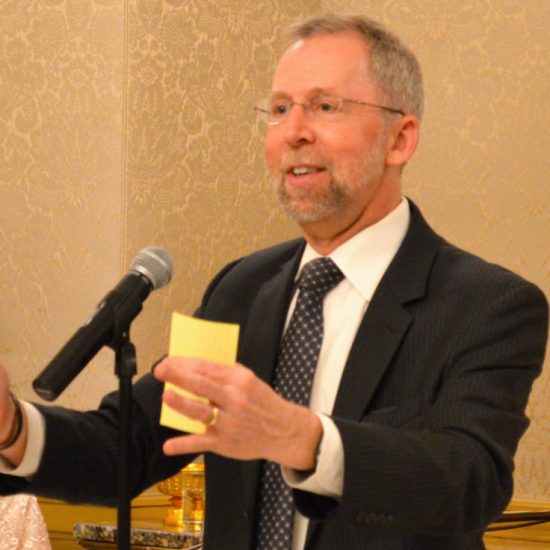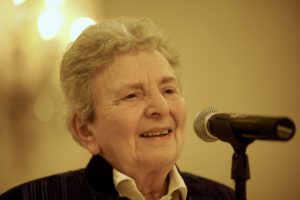Human Genome Project Team at NIH Honored for Advancing Research into Genetic Diseases

Dr. Eric Green speaks at the Prince Mahidol Awards ceremony in Washington. (Photo courtesy of Royal Thai Embassy)
It’s not every day a Southeast Asian monarchy bestows a $100,000 prize on a U.S. government research agency. In fact, it rarely happens.
But this year is different. Thailand’s Prince Mahidol Award Foundation has chosen the National Human Genome Research Institute — a division of the National Institutes of Health (NIH) — to receive its 2017 Prince Mahidol Award for groundbreaking advances in the field of medicine.
Specifically, the award recognizes the institute for leading NIH’s work on the Human Genome Project. Its director, Eric D. Green, MD, PhD, received the award Jan. 31 during a royal ceremony at Bangkok’s Grand Palace presided over by Princess Maha Chakri Sirindhorn.
He and four recipients of a separate award in the field of public health were honored at a dinner in Washington, D.C., on April 23 hosted by the Royal Thai Embassy.
“The Human Genome Project, launched in 1990, was one of the largest research projects in genetics,” said Virachai Plasai, Thailand’s ambassador to the United States, speaking on his very first day on the job to about 50 invited dinner guests at Washington’s St. Regis Hotel.
“Its mission was to decipher human genetic codes and contribute to a better understanding of cellular and organ functions, mutation processes and mechanisms of diseases — from rare hereditary diseases to common illnesses.”
Some 80 percent of the 7,000 or so known rare diseases are genetic in origin, and about half of those affected are children — yet 95 percent of such diseases don’t have a single treatment approved by the U.S. Food and Drug Administration. Rare diseases cause more than a third of all deaths in the first year of life, and an estimated 30 percent of kids with a rare disease will not live to see their fifth birthday.
“Information provided by the Human Genome Project has helped make significant progress in medical science,” Plasai said. “In particular, it has changed the medical paradigm of the investigation of causes and related genetic risks of diseases.”
Since its establishment in 1992 to honor Prince Mahidol of Songkla — considered the father of modern medicine and public health in Thailand — the royal family has given the award to 78 individuals and two institutions in 23 countries. This year, however, all five laureates represent the United States.
Green, speaking on behalf of his colleagues, was a “start-to-finish” researcher on the Human Genome Project before becoming director of the National Genome Research Institute in 2009.
“This was an international effort that took place from 1990 to 2003, involving thousands of scientists from around the world — to decode the human blueprint of DNA and make that information available to scientists everywhere,” he said. “That effort, which involved multiple countries, completed its endeavor 15 years ago. It is changing the way we practice medicine, and the fact it’s doing so only 15 years later is incredible.”
He said that the resulting human genome sequence “has provided a foundation on which researchers and clinicians now tackle increasingly complex problems,” transforming the study of human biology and disease.
“Particularly gratifying has been the ability to begin using genomics to improve approaches for diagnosing and treating human disease, ushering in the era of genomic medicine,” said Green.
In addition to Green and his team, the 2017 winners in the field of public health are five scientists who improved the vaccine for Haemophilus influenzae type b — also known as Hib — which is the leading cause of bacterial meningitis among Americans under the age of 5.
The laureates are Rachel Schneerson, MD, and John Robbins, MD, who headed a research team when both worked at the Eunice Kennedy Shriver National Institute of Child Health and Human Development; Porter Anderson, PhD, of Harvard University and New York’s University of Rochester; and Mathuram Santosham, MD, of Baltimore’s Johns Hopkins University.
“It is gratifying, of course, to have our work recognized, and the contributions of our many colleagues — both in and out of the lab — that we were lucky to have over the years, should be acknowledged,” said the Polish-born Schneerson, 85, who graduated from Israel’s Hebrew University Hadassah Medical School in 1958, spent most of her career in the United States and retired in 2012.
“The importance of this award is in highlighting health and scientific problems facing us, showing us what was and what can be done, and encouraging young people to further this work and prevent infectious diseases for the benefit of all,” she said.









